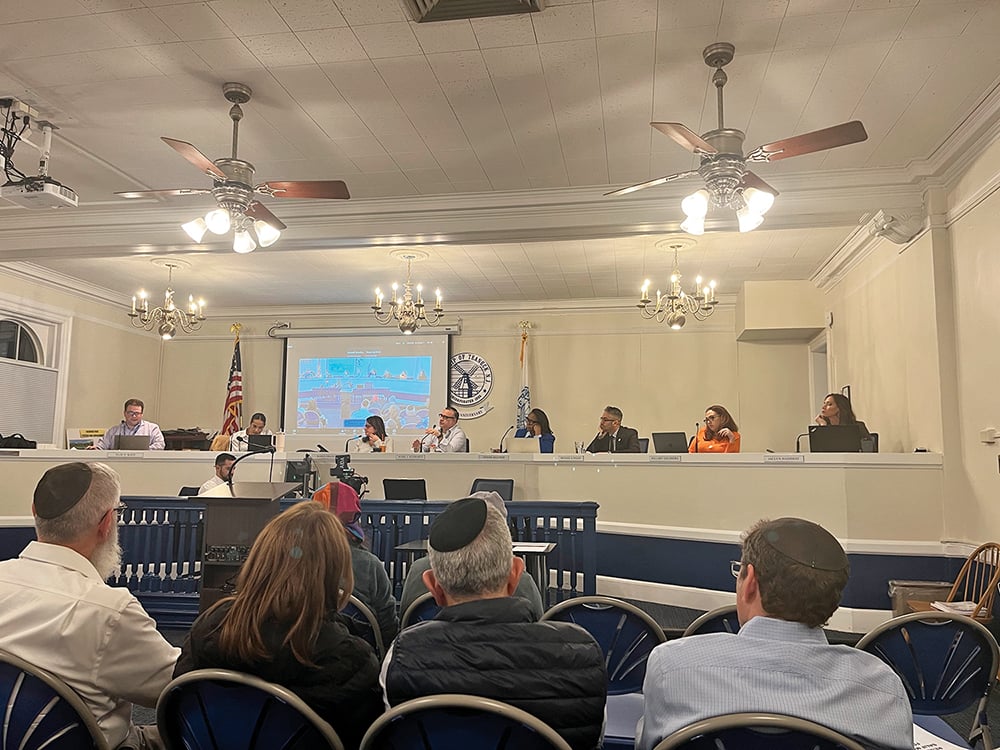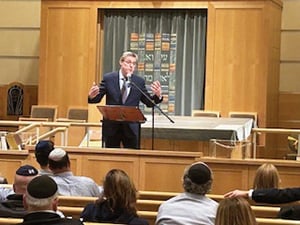
Reviewing: “The Real Zalman” by Rabbi Chaim Dalfin. Jewish Enrichment Press. 2023.
Samuel Johnson (18th Century English literary giant) wrote, “Be not too hasty to trust, or to admire, the teachers of morality; they discourse like angels, but they live like men.” After reading “The Real Zalman,” Rabbi Chaim Dalfin’s new book about Rabbi Zalman Schachter-Shalomi, Johnson’s admonition rings true. Rabbi Schachter-Shalomi, regarded as the founder of the Jewish Renewal Movement, was a charismatic figure who attracted many followers with his storytelling, charisma, empathy and knowledge. He could indeed “discourse like an angel.” What Rabbi Dalfin’s book shows, though, is that he also “lived like men;” sometimes even more so.
Much material is available about the Jewish Renewal Movement generally, as well as Rabbi Schachter-Shalomi’s contributions thereto. Some scholars, like Jonathan Sarna in “American Judaism: A History,” or Dana Kaplan in “Contemporary American Judaism: Transformation and Renewal,” take a historical approach to the subject. Others, like Rabbi Arthur Green and Arial Evan Mayse, who edited the two-volume treatise entitled “A New Hasidism: Branches and Roots,” combine the historical information with a more philosophical approach to understanding Jewish renewal and its place in the denominational spectrum. In addition, numerous videos of Reb Zalman (as he was known) are freely available on YouTube and other websites, including the website for ALEPH: Alliance for Jewish Renewal.
Given this plethora of information on Reb Zalman and Jewish Renewal, a fair question is to ask what Rabbi Dalfin brings to the table. By his own admission, Rabbi Dalfin did not intend to (nor did he) write a complete biography of Reb Zalman. Moreover, “The Real Zalman” is not, strictly speaking, a complete history of Reb Zalman or the Jewish Renewal Movement. Although Rabbi Dalfin covers Reb Zalman’s connection to Chabad from 1939 until 2014, the book primarily covers Reb Zalman’s activities in the early 1940s and between 1956 and 1975, with helpful supplemental and more current information interspersed throughout.
Instead, the book falls into what is called “historiography.” It is a critical analysis of key historical sources about Reb Zalman’s life and a selection of details from available material. Rabbi Dalfin exhaustively researched the historical record and personally interviewed Reb Zalman (the interview transcript is found in chapter six of the book), in addition to 25 others with first-hand information. He also listened to 40 interviews online of those who knew Reb Zalman. Rabbi Dalfin then synthesized the details of that research into his own narrative, which he makes available to his readers for their critical examination.
Right up front, in the introduction, Rabbi Dalfin articulates his goal to “set the record straight on three fundamental issues that academics, Chabadniks, and the media write and say that are factually wrong.” First, Rabbi Dalfin argues that Reb Zalman was not appointed by the Lubavitcher Rebbe as a “shaliach” (or official Chabad emissary) to college students. Second, he maintains that the Rebbe opposed, not approved of, Rabbi Schachter-Shalomi’s use of psychedelics (especially LSD) to stimulate mystical inspiration or insights. Third, Rabbi Dalfin asserts that the Rebbe did not ask Reb Zalman (in 1991) to think about the Rebbe as Reb Zalman performed the priestly blessings (birchas Kohanim) during the High Holiday season. For the most part, these fundamental issues are resolved (although stronger proof of the first point would have been welcome).
Importantly, Rabbi Dalfin clarifies that he has no ax to grind with Reb Zalman or Jewish Renewal; he is not settling old scores in any material sense. Instead, his goal is to let the academic world, particularly the Renewal world, know the “Zalman Schachter that lay beyond ecumenism, Buddhism and Sufism.” Yes, Reb Zalman may have (to some) discoursed like an angel. Yet he most definitely lived like a man, as Rabbi Dalfin tells it, apparently struggling with the consequences of his character flaws on the one hand and, on the other, his insatiable curiosity for Chasidic knowledge and understanding behind what it means to pray (“Davenen” or “Davenology” as he called it) and his search to derive spiritual meaning out of prayer.
Rabbi Dalfin, a well-known Chabad historian, ethnographer and author of over 90 books, writes with a unique conversational style instead of a formal detached academic style (with its punctilious punctuation and syntactical correctness). Those who have learned with Rabbi Dalfin or watched any of his numerous videos can hear his voice come through the pages; the book literally “sounds” like Rabbi Dalfin is speaking to the reader.
Over the course of the first couple of chapters, Rabbi Dalfin manages to draw the reader into Reb Zalman’s life beginning in 1924 with his birth in Zolkiew (then Poland and now Ukraine) and early family life and then progressing through Zalman’s years in the Lubavitcher yeshiva system. The reader learns of Reb Zalman’s strong emotional attachment to the sixth Lubavitcher Rebbe (the Rebbe Raayatz) and his close personal relationship with the seventh and last Lubavitcher Rebbe.
This material forms the starting point for Rabbi Dalfin’s claim that “Reb Zalman was first and foremost a Lubavitcher.” Yes, Reb Zalman created numerous innovations, and the remaining chapters of “The Real Zalman” explore many of these innovations, his personal life and “Renewal life” in detail. Without a doubt, many of Reb Zalman’s activities were not precisely congruent with a traditional Lubavitcher lifestyle. Whether it was “his work in Jewish Renewal, interfaith dialogue, ordination of women, acceptance of lifestyle choices, innovation in prayer, or drug use as a spiritual tool,” Reb Zalman’s choices caused what is frequently referred to as his “split” with Chabad (or what Reb Zalman called his “graduation” from Chabad).
In the end, though, Rabbi Dalfin strikes a more sympathetic note in describing the last 19 years of Reb Zalman’s life when he moved to Boulder, Colorado, and achieved a sense of “harmony and peacefulness.” At that time, he cultivated closer relationships with Chabad, including leaving detailed instructions for his burial in accordance with “the highest standard of Jewish Law and Chabad customs.” By Rabbi Dalfin’s telling, this seems like Reb Zalman achieved a degree of self-reconciliation as he looked back on his life and tapped into his Lubavitcher roots.
Structurally, “The Real Zalman” is more like three books within a book. The first five chapters are devoted to Rabbi Dalfin’s examination of the “real” Reb Zalman story. This part ends with 20 pages of newspaper clips about Reb Zalman over the years. These clippings are especially helpful for the reader who does not want to take Rabbi Dalfin’s word for it; instead, armed with objective evidence, readers can form their own conclusions about the accuracy of Rabbi Dalfin’s historiography.
Rabbi Dalfin also provides the lengthy transcript of his 2010 two-hour interview with Reb Zalman. In truth, nothing can compare to watching the interview, which is readily available on YouTube. But the written transcript is instrumental to supporting Rabbi Dalfin’s more general explanations. The book then includes two additional appendices—an interview with Yisroel and Golda Rochel Rosencranz (students of Reb Zalman in later years) and a 1959 letter from Reb Zalman to his first wife where he wrote of his reflections upon visiting Meah Shearim in Israel. This supplemental material puts Reb Zalman’s views in context and rounds out the reader’s understanding of his life.
In short, Rabbi Dalfin compellingly explains how Reb Zalman was able, through “charisma, smarts, and vast Torah and secular knowledge” to attract a large following “that accepted him as their leader.” Yes, he broke with “Lubavitch, the Rebbe, Orthodoxy and even family” and created a new family with the Jewish Renewal community. In the end, however, Rabbi Dalfin clearly conveys a sympathetic explanation of why, in Rabbi Dalfin’s view, Reb Zalman “missed his Rebbe and Lubavitch world.”
“The Real Zalman” is a valuable addition to the literature on Reb Zalman and the Jewish Renewal Movement. Admittedly, by its terms, the book focuses on Reb Zalman and his perceived faults and motivations at the expense of any serious analysis or engagement with Reb Zalman’s “philosophy,” as explored in other sources. Nevertheless, what the other sources gloss over or ignore entirely about Reb Zalman’s life, Rabbi Dalfin examines, documents and analyzes in his inimitable style, which affords the reader a clearer understanding of Reb Zalman the person—the real Zalman. It is a book to read, study and then read again.
“The Real Zalman” is available at www.rabbidalfin.com.
Shlomo M. Hamburger is a long-time student of Rabbi Chaim Dalfin, author of “The Real Zalman.” He is a partner at an international law firm and is the author of several publications on Chassidic topics.










